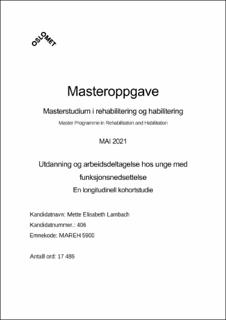| dc.contributor.advisor | Drange, Ida | |
| dc.contributor.advisor | Tufte, Per Arne | |
| dc.contributor.advisor | Søberg, Helene Lundgaard | |
| dc.contributor.author | Lambach, Mette Elisabeth | |
| dc.date.accessioned | 2024-03-22T10:18:56Z | |
| dc.date.available | 2024-03-22T10:18:56Z | |
| dc.date.issued | 2021-05 | |
| dc.identifier.uri | https://hdl.handle.net/11250/3123790 | |
| dc.description.abstract | Unge med utfordringer kan i møte med utdanningsinstitusjonene og arbeidslivet møte lite forståelse for hvordan en best mulig kan tilrettelegge utdanning, yrkesvalg og arbeid for den enkelte. Noe som kan få konsekvenser for forløpet med å fullføre utdanning og bli yrkesaktiv.
Hensikten med studien er å kartlegge forløpet med utdanning og arbeid for unge med funksjonsnedsettelse i forhold til funksjonsfriske i perioden fra de er 16 til 30 år. Studien vil undersøke om de fullfører utdanning, på hvilket nivå og om graden av utdanning har innvirkning på om de er i arbeid. Videre er det sett på yrkesvalg og graden av yrkesaktivitet.
Studien er en kvantitativ studie som benytter seg av registerdata fra microdata (SSB) for å kartlegge og sammenligne utdanning og arbeid for personer som ble født i 1985 og som bodde i Norge mellom 2001-2015. Studien ser på endring og sammenligning mellom personer med og uten funksjonsnedsettelse over en femtenårsperiode.
Resultatene i studien viser at en større andel med funksjonsnedsettelse har lavere grad av fullført utdannelse sammenlignet med funksjonsfriske på samme alder. Sannsynligheten for å fullføre videregående-, bachelor- og masterutdanning i følgeperioden konvergerer ikke. Forskjellene øker over tid når en sammenligner med funksjonsfriske i kohorten. Sannsynligheten for å være yrkesaktiv når en sammenligner funksjonsfriske og funksjonsnedsatte er lavere for funksjonsnedsatte og forskjellen øker mellom gruppene over tid. Det er forskjell i andel som arbeider fulltid i forhold til funksjonsgrad. Forløpet mellom fulltidsarbeidende menn og kvinner med funksjonsnedsettelse endrer seg likt i følgeperioden. Yrkestilhørigheten er ulik i forhold til populasjonens funksjonsgrad og viser endring i følgeperioden. Det er vist at funksjonsnedsatte uten fullført videregående opplæring har en signifikant lavere sannsynlighet for å være yrkesaktive enn funksjonsnedsatte med fullført videregående opplæring.
Studien viser at personer med funksjonsnedsettelse har lavere sannsynlighet for å fullføre videregående opplæring enn funksjonsfriske. Den viser også at det er en sammenheng mellom fullført videregående utdanning og arbeidsdeltagelse for funksjonsnedsatte i kohorten. Denne studien har funnet at både funksjonsnedsatte og funksjonsfriske i kohorten, har klart å fullføre høyere utdanning som kvalifiserer til jobb innenfor akademiske yrker og denne andelen yrkesaktive utgjør den største yrkeskategorien ved utgangen av følgeperioden i 2015.
Nøkkelord: Funksjonsnedsettelse, utdanning, frafall, mestring, inkludering, arbeidsdeltagelse, yrke. | en_US |
| dc.description.abstract | In meetings with educational institutions and working life, young people with challenges may encounter little understanding of how best to facilitate education, career choices and work for the individual. This may have consequences for the process of completing education and becoming employed.
The purpose of the study is to map the course of education and work for young people with disabilities in relation to the functionally healthy in the period from the age of 16 to 30 years. The study will examine whether they complete education, at what level and if the degree of education has an impact on whether they are employed. Furthermore, the study looks at the choice of profession and the degree of professional activity.
The study is a quantitative study that makes use of register data from microdata (SSB) to survey and compare the education and employment for people who were born in 1985 and who lived in Norway between 2001-2015. The study looks at the change and comparison between individuals with and without impairment over a fifteen years period.
The results of the study show that a larger proportion with disabilities have a lower degree of completed education compared to functionally healthy people of the same age. The probability of completing upper secondary, bachelor's and master's education in the follow-up period does not converge. The differences increase over time when compared with functional healthy in the cohort. The probability of being active when comparing the able-bodied and the disabled is lower for the disabled and the difference increases between the groups over time. There is a difference in the proportion who work full time in relation to degree of function. The course between full-time working men and women with disabilities changes equally in the follow-up period. Occupational affiliation is different in relation to the population's degree of function and shows a change in the follow-up period. It has been presented that disabled people without completed upper secondary education have a significantly lower probability of being employed than disabled people with completed upper secondary education.
The study shows that people with disabilities are less likely to complete upper secondary education than people without disabilities. It also shows that there is a connection between completed upper secondary education and work participation for the disabled in the cohort. This study has found that both disabled and able-bodied people in the cohort have managed to complete higher education that qualifies for work in academic professions and this proportion of working people constitutes the largest occupational category at the end of the follow-up period in 2015.
Keywords: Disability, education, dropout, coping, inclusion, work participation, occupation. | en_US |
| dc.language.iso | nob | en_US |
| dc.title | Utdanning og arbeidsdeltagelse hos unge med funksjonsnedsettelse : En longitudinell kohortstudie | en_US |
| dc.type | Master thesis | en_US |
| dc.description.version | publishedVersion | en_US |
